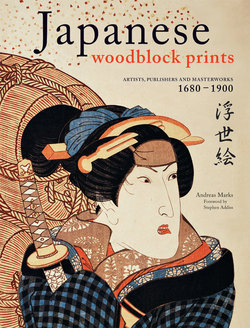Читать книгу Japanese Woodblock Prints - Andreas Marks - Страница 18
На сайте Литреса книга снята с продажи.
ОглавлениеShigenaga
1697?–1756
Art surname: Nishimura. Art names: Eikadō (until c.1730s), Senkadō (from c.1730s), Hyakuju.
Nishimura Shigenaga was born in Edo around 1697. He first lived in Tōriabura-chō but later moved to the Kanda district where he opened a bookshop. He was self-taught and not the student of a lineage of artists. His earliest work seems to have appeared in 1719 and he became a rival to the Okumura School. He sometimes imitated their style but was also influenced by Nishikawa Sukenobu (1671–1750) and Torii Kiyonobu I. Shigenaga did not focus on a specific genre but is known for a wide range of subjects including actors, classical literature, landscapes, and flowers and birds (kachō-e). His works were published in different formats like the narrow hosoban format, and produced as urushi-e (lacquer pictures), beni-e (pink, hand colored pictures), benizuri-e (two-color-printing), ishizuri-e (stone prints: woodblock prints with white outlines against a black background, resembling stone rubbings). The center figure is an example from an untitled series depicting the “Eight Views of Lake Ōmi” (Ōmi hakkei). Amongst his most famous works are the series “The Fifty-four Sheets of Genji” (Genji gojūyonmai no uchi) that he created together with Torii Kiyomasu II from c.1730–35, and the gazetteer “Picture Book of Edo Souvenirs” (Ehon Edo-miyage) from 1753.
He greatly influenced both Sukuki Harunobu and Ishikawa Toyonobu, who are sometimes seen as his students. His signature is occasionally preceded by the expressions “Yamato gakō” (Yamato painting artisan) or “Nihon gakō” (Japan painting artisan).
Some sources erronously suggest that he signed his works also as Nishimura Magosaburō, however it was Nishimura Shigenobu (act. c.1723–47) who used the name Magosaburō early in his career.
c.1720s/30s “Mapple leaves in fall” (Aki no momiji yakata fū). Hosoban urushi-e. Publisher: Maruya Kuzaemon. National Museum of Ethnology, Leiden, The Netherlands.
1720s “Sunset Glow at Seta” (Seta no sekishō), from an untitled series on the “Eight Views of Lake ōmi”. Hosoban urushi-e. Publisher: Emiya Kichiemon. Collection Peter Rieder.
c.1720s/30s. “Chin Nan” (Ch. Chen Nan) conjures a dragon out of a gourd causing a rainstorm. Hosoban beni-e. Publisher: Kinoshita Jin’emon. Asian Art Museum, National Museums in Berlin.
c.1720s/30s Flower vendor. Hosoban beni-e. Publisher: Igaya Kan’emon. Library of Congress.
1730s “In the fashion of a stylish priestess” (Imayō bikuni fū). Hosoban urushi-e. Publisher: Fujita Chōbei. Asian Art Museum, National Museums in Berlin.
